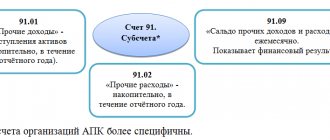Account 96: its use
To summarize information that gives an idea of the organization’s future expenses distributed throughout the year, account 96 “Reserves for future expenses” is intended. Its purpose is to uniformly include costs for upcoming production costs and sales costs.
Reserves for future expenses consist of:
- holiday expenses;
- one-time payments to employees;
- current repair of equipment, OS;
- development of new production facilities;
- other possible expenses of the organization.
When creating reserves, costs are charged to the following accounts depending on the final purpose:
| Name of reserve | Target | Accounts used in accounting |
| To pay for vacations | Funds are allocated to provide vacations to employees throughout the year | 70, 69 |
| To pay benefits to employees for length of service and others | Creating reserves for one-time payments to employees, allocating funds to pay seasonal workers | 70, 69 |
| OS repair | Possible amounts required for routine maintenance (repair) of property and equipment are determined | 20,23 |
| Land reclamation | Designed for environmental protection activities | 20, 23 |
| Warranty repairs and maintenance | Reimbursement of expenses to customers for defective goods purchased under warranty service | 51 |
Under what obligations to form
Government institutions form reserves in account 401 60 “Reserves for future expenses” in accordance with clause 302.1, introduced into the Instructions for the application of the Unified Chart of Accounts dated December 1, 2010 No. 157n by Order of the Ministry of Finance of the Russian Federation dated August 29, 2014 No. 89n to summarize information on the status and movement of reserved amounts.
As follows from the letter of the Ministry of Finance of the Russian Federation dated May 20, 2015 No. 02-07-07/28998 “On the procedure for recording transactions with deferred liabilities”, reserves are formed in order to generate complete and reliable information about the obligations of a public legal entity (state (municipal) institution ) according to the accrual method, which provides for the reflection of expenses in the period to which they relate, regardless of when the funds were paid, as well as for evenly attributing expenses to the financial result of the institution, including for calculating corporate income tax.
Reserves can be formed for obligations arising, firstly , as a result of a transaction (conclusion of an agreement), an event, operation that affects the financial position of the institution, the financial result of its activities and (or) cash flow:
- for the upcoming payment of vacations for actually worked time or the provision of compensation for unused vacations, including upon dismissal, including payments for compulsory social insurance of an employee of the institution;
- for upcoming payment at the request of buyers for warranty repairs, routine maintenance in cases provided for in the supply agreement;
- for other similar upcoming payments.
Secondly , when making a decision on restructuring the activities of the institution, including the creation, changing the structure of separate divisions of the institution, changing the types of activities of the institution, as well as during the reorganization or liquidation of the institution.
Thirdly , obligations arising from claims and actions, including within the framework of pre-trial or out-of-court consideration of claims.
In this case, the reserve will be calculated for the amount of penalties and other compensation for damage caused to the institution. In addition, the reserve should also include the amount of expected legal costs in the event that claims or other similar expected expenses are presented to the institution in accordance with the legislation of the Russian Federation.
Fourthly , when accepting obligations, you should pay attention to the facts of economic activity, the accrual of which at the reporting date there is uncertainty in their size, for example, due to the lack of primary accounting documents.
Also, when forming a reserve, it is necessary to take into account all other obligations that are not determined by the amount and time of fulfillment - in cases provided for by the act of the institution adopted when forming its accounting policy.
The created reserve should be used only to cover those costs for which it was originally created. Recognition in accounting of expenses for which a reserve for future expenses has been formed is carried out at the expense of the amount of the created reserve.
Account 96: typical entries
The figure below shows accounting account 96 “Reserves for future expenses” and its typical entries. To enlarge the picture, click on it.
Accounting account 96 “Reserves for future expenses.” Postings
| ★ Best-selling book “Accounting from scratch” for dummies (understand how to do accounting in 72 hours) > 8000 books purchased |
Reflection of reserves in accounting
Recently, the formation of reserves has become mandatory for legal entities. An exception is made for organizations that have the right to maintain simplified accounting (small enterprises).
The procedure for forming reserves is not legally established. Organizations have the right to develop an algorithm themselves and prescribe it in their accounting policies. If, for example, the number of employees is significant, it is allowed to create reserves for upcoming vacations quarterly or throughout the year.
If in accounting the creation of reserves has become mandatory, then in taxation the procedure is determined at the discretion of management. The adoption of such a decision should also be reflected in the accounting policy. The reserve created in tax accounting allows you to reduce the tax base. You should decide on the maximum contribution amount and monthly interest. A calculation is drawn up that contains information about the planned amounts of monthly expenses based on data on the total annual costs of reserves of a certain type.
Reserves for vacation pay and other payments
Management has the right to take into account upcoming expenses intended to pay off the debt to pay vacation pay to its employees and distribute them evenly throughout the year.
When determining the annual amount of the vacation reserve, you should take into account all expected payments, including contributions to the Pension Fund and the Social Insurance Fund, and calculate the percentage of contributions to the reserve based on possible vacation amounts and the annual wage fund.
Example . The annual payroll together with insurance payments in the organization is planned in the amount of 900,000 rubles. The estimated amounts of vacation pay and related contributions are equal to 80,000 rubles. It is required to calculate the percentage of contributions to the reserve.
The monthly amount for replenishing the reserve is determined as the ratio of vacation amounts to payroll for the year, divided by the number of months (12) - 80,000/900,000/12*100% = 0.74%.
The amount of monthly deductions is equal to 900,000 rubles* 0.74%= 6,660 rubles - this amount must be transferred monthly to the reserve for upcoming vacation payments.
The following entries will appear in the accounting:
Dt 20 - Kt 96 (6,660 rubles) - monthly reserve formation
When an employee takes leave, the following transactions appear:
Kt 96 - Dt 70 - accrual of vacation amounts;
Kt 96 - Dt 69 - insurance premiums for vacations.
If it is necessary to allocate amounts for payments to employees for long service, planned expenses are also reserved for 12 months.
Upon expiration of the period, an inventory of reserves is required. The procedure is necessary to compare actual and planned costs. If unused reserved amounts are discovered, they should be included in the tax base. If there are insufficient funds, additional payments for vacations and insurance premiums are included in the expenses.
Reflection in accounting
When creating a reserve, vacation expenses can only be written off against this reserve.
The formed reserve is reflected in account 96 “Reserves for future expenses”. The reserve amounts are accrued by debiting expense accounts that record employee salaries:
DEBIT 20 (23, 25, 26, 29, 44...) CREDIT 96
— an estimated reserve for vacation pay has been accrued.
As employees go on vacation, the accountant accrues vacation pay, insurance contributions for health insurance, social insurance, compulsory medical insurance and contributions for “injuries” from the reserve.
Postings are reflected in the debit of account 96 in correspondence with accounts 70 and 69:
DEBIT 96 CREDIT 70
— vacation pay is accrued from the reserve;
DEBIT 96 CREDIT 69
— insurance premiums for OSS, compulsory health insurance, compulsory medical insurance and contributions for “injuries” are calculated at the expense of the reserve.
In tax accounting, a company may or may not create a reserve for vacation pay (Article 324.1 of the Tax Code of the Russian Federation). If a holiday reserve is not created in tax accounting, then differences and associated deferred tax assets will arise. The wiring is completed:
DEBIT 09 CREDIT 68
— a deferred tax asset has been formed (in the amount of the estimated liability × 20%).
When vacation pay is actually accrued, this asset is extinguished:
DEBIT 68 CREDIT 09
— the deferred tax asset is repaid (by the amount of accrued vacation and insurance contributions × 20%).
EXAMPLE 1. ACCRUAL AND USE OF RESERVE FOR PAYMENT OF HOLIDAYS IN ACCOUNTING
In tax accounting, Vesna LLC does not create a reserve for upcoming expenses for payment of vacations.
Let’s assume that as of March 31, the company’s accounting records recognized an estimated liability for the payment of vacation pay in the amount of 50,000 rubles. The following entries were made in the accounting: DEBIT 20 CREDIT 96
- 50,000 rubles.
– the amount of the estimated liability is reflected; DEBIT 09 CREDIT 68
- 10,000 rub.
(50,000 rubles × 20%) – a deferred tax asset is reflected. In the second quarter, employees were accrued vacation pay (together with insurance contributions) in the amount of 50,000 rubles. and additionally, estimated liabilities for vacation pay were recognized in the amount of 100,000 rubles. The following entries were made in accounting: DEBIT 96 CREDIT 70 (69)
- 50,000 rubles.
– vacation and insurance contributions accrued; DEBIT 68 CREDIT 09
- 10,000 rub.
(RUB 50,000 × 20%) – the deferred tax asset is written off; DEBIT 20 CREDIT 96
- 100,000 rub.
– the amount of the estimated liability is reflected; DEBIT 09 CREDIT 68
- 20,000 rub. (RUB 100,000 × 20%) – a deferred tax asset is reflected.
Reserves for repairs of fixed assets (fixed assets)
Each equipment on the enterprise's balance sheet may suddenly fail or require additional investments in the form of routine repairs. For such unforeseen needs, reserves are created for OS repairs. The basis is the validity period of the equipment and the expected amount.
Factors influencing the estimated amount:
- cost of spare parts;
- wages and costs of insurance premiums for workers involved in repairs;
- costs of paying for services to third parties.
The maximum amount of contributions to the reserve cannot be higher than the funds spent on OS repairs based on data for the last 3 years. Deductions for expenses are written off evenly throughout the reporting period.
If the actual amount of expenses turned out to be less than planned, then previously made contributions to the reserve should be taken into account as part of the income for the year. If actual costs exceed actual costs, additional amounts are included in other expenses.
Creating a reserve for OS repairs in tax accounting is a right, not an obligation, of the taxpayer. Beneficial for large organizations with a large amount of equipment.
Vacation reserve as an estimated liability
According to PBU 8/2010 “Estimated Liabilities”, organizations must create certain amount-weighted liabilities in their accounting accounts. That is, financial statements must contain not only data on the company’s documented obligations to contractors and third parties, but also information on planned expenses that are inevitable.
For example:
- on future vacations of employees;
- planned tax assessments;
- costs for suppliers in terms of expenses that we know for sure that they will be (for example, if a work completion certificate already exists, but has not yet been signed, so it cannot yet be recorded, although it is known for sure that the director will sign the document will be held next month).
With the advent of this information, the balance sheet becomes the most reliable, since it reflects the most realistic picture of the financial position of the enterprise. Let's take a closer look at what a reserve for vacation pay is.
Each employee, in accordance with labor legislation, is entitled to at least 28 calendar vacation days, and in a number of legally established cases this figure may be higher. Thus, for each reporting date we have vacation days that have not yet been used by employees (it is difficult to imagine an organization in which all employees took 28 vacation days at once). Accordingly, for each reporting date, there are estimated obligations of the company to employees to pay for these days and, as a result, certain obligations to funds to pay insurance premiums.
Who is responsible for reporting this information? In accordance with paragraph 3 of PBU 8/2010, all companies are required to reflect these accruals, with the exception of small enterprises (issuers of securities are not included in such exceptions), which can use a simplified method of accounting. The characteristics of such companies are specified in the Law “On Accounting” dated December 6, 2011 No. 402-FZ.
Thus, if a company does not fit the definition of a small business entity, the accrual of valuation reserves becomes mandatory, and the absence of this information on the accounting accounts may be regarded as a violation of the rules for accounting for income and expenses. Responsibility for this comes on two grounds:
- for gross violation of accounting for income and expenses under Art. 120 of the Tax Code of the Russian Federation in the amount of 10,000−30,000 rubles;
- administrative liability applied to officials under Art. 15.11 Code of Administrative Offences.
If a company creates a reserve for vacation pay, it is necessary to stipulate this in the accounting policy, as well as the procedure for calculating this reserve.




